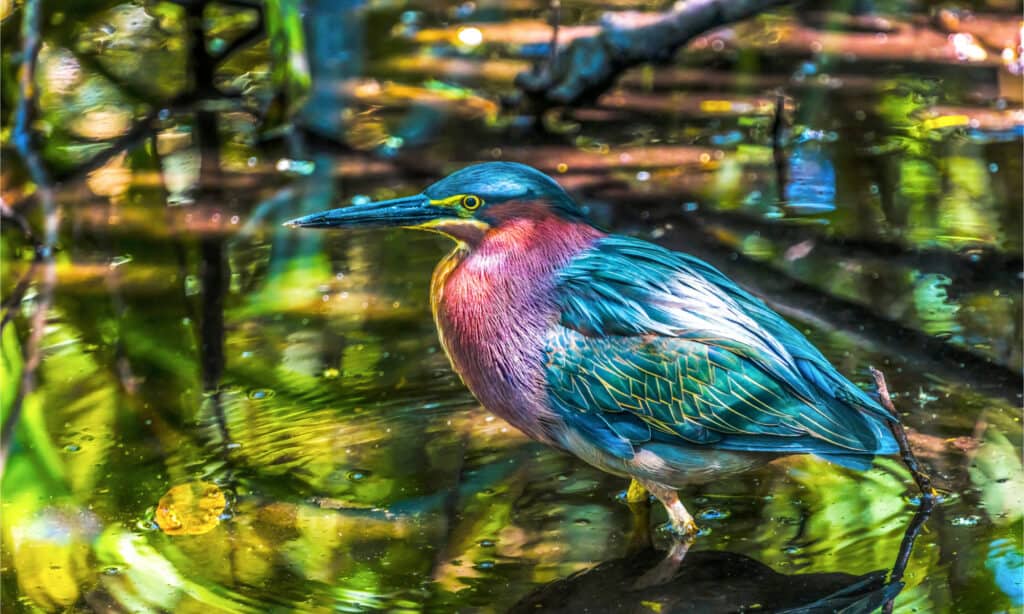Green Heron
Butorides virescens
Uses bait to catch prey
Advertisement
Green Heron Scientific Classification
- Kingdom
- Animalia
- Phylum
- Chordata
- Class
- Aves
- Order
- Pelecaniformes
- Family
- Ardeidae
- Genus
- Butorides
- Scientific Name
- Butorides virescens
Read our Complete Guide to Classification of Animals.
Green Heron Conservation Status
Green Heron Facts
- Prey
- Small fish, grasshoppers, snakes, earthworms, snails, rodents
- Group Behavior
- Solitary
- Fun Fact
- Uses bait to catch prey
- Estimated Population Size
- Unknown, but widespread and stable
- Biggest Threat
- Hunting and loss of habitat
- Most Distinctive Feature
- Dark crown feathers, which are sometimes in the form of a crest
- Wingspan
- 25.2 to 26.8 inches
- Incubation Period
- 19-21 days
- Type
- Bird
- Common Name
- Green heron
- Number Of Species
- 1
- Age of Molting
- 2 years
- Migratory
- 1
View all of the Green Heron images!
The green heron is a little bird, and it ranges greatly in its preferred environment.
Primarily found in the United States (including Hawaii), Mexico, and Central America, these beautiful creatures make their presence known with many identifiable calls. They are carnivores, but their diet is primarily of fish. They’ll mate monogamously for the breeding season, building a nest with and caring for their hatchlings with their partner.
4 Amazing Green Heron Facts
- The fast movements of the green heron’s neck during its courting ritual are referred to as a “zoop.” Zoop may also refer to their quick movements while in flight.
- Though it was previously categorized as the same species as the striated heron, it has since been identified as its own species. The two birds were collectively considered to be the “green-backed heron.”
- The green heron uses tools when they are trying to lure prey, treating it as bait.
- If the green heron attempts to consume a frog, they’ll drown it before swallowing the entire animal.
Where to Find Green Herons
Green herons prefer small wetland environments in low-lying places, which could be why it is found so often in Hawaii. The warm climate is ideal for its desired habitat, though you’ll probably only see it around sunrise and sunset. They are nocturnal creatures, sheltered in daylight apart from feeding. They can be found throughout the United States, Mexico, and Central America, residing along riverbanks and streams.
Green Heron Nests
You’ll rarely see a green heron in a nest with other groups as they prefer to eat and live alone. The nesting territory is primarily chosen by the male, signifying the spot to females with various calls. They prefer a tree or shrub to perch from, though the nest itself is built as a platform of sticks. The male starts the initial construction, while the female builds it with the materials provided to her by the male.
Scientific Name
The green heron has the scientific name Butorides virescens, which is a combination of Middle English and Ancient Greek languages. Butorides is comprised of two words – “butor” (“bittern”) and “-oides” (“resembling”). “Virescens” comes from the Latin word meaning “greenish.” Originally, the name was Butorides striata, and it connected the bird to fossils in Florida.
Its class is Aves, and it is from the Ardeidae family.
Size, Appearance, and Behavior
The green heron is a little bird at only 17 inches long from beak to tail, while their wingspan is 25.2 to 26.8 inches. Their neck is short, and the head is decorated with a glossy greenish-black cap. They also have a green-colored back and wings, though the color can range from black and grey to green or blue. The neck is chestnut brown, decorated by a white line vertically down their neck. The green hue of this heron is much more vibrant in Hawaii.
Between males and females, the latter is quite little. Juveniles have a duller appearance, though they still have some green in their legs and bill. When they are only hatchlings, their body is covered in light grey down feathers, adorned with a white belly.
There is no mistaking the loud noise of the green herons call. Generally, it is a “key-yow” sound, though they’ll make noises that sound like “kuk” at a much lower volume. These calls change when the male is seeking a mate, giving more of a “rahh-rahh” call that they make with a wide-open bill. While in flight, the call becomes more of a “whoom-whoom-whoom.” The quick zoop through the air allows it to stay in motion, using its neck quickly during movement.

Green herons are only 17 inches long from beak to tail.
©Bill Perry/Shutterstock.com
Migration Pattern and Timing
Not all of these birds migrate. While the green herons in the southern states and in Central America primarily remain in the same area throughout the year, populations in the northern United States will move further south around March or April to have their brood. Migration starts in September, but global warming has seemingly had no impact on this habit, taking the birds to the same breeding grounds that they’ve visited for the last century.
Populations that don’t migrate will roam around their regions after they’ve finished breeding. Some of the migratory populations will go as far south as Panama.
Green Heron Diet
The reason that the green heron tends to live near bodies of water is because much of their diet consists of small fish and other aquatic life. The species does not like to eat around other wild birds and they will refuse to forage around other groups. Instead, they’ll wait for prey as they perch on branches or in shallow water, allowing the prey to get close to them. They will even use little twigs and feathers to get fish to come close to them so they can catch them as food.
What does the green heron eat?
The main prey of the green heron includes frogs, leeches, mice, minnows, sunfishes, gizzard shad, crayfish, tadpoles, grasshoppers, snakes, earthworms, snails, and small rodents.
Predators, Threats, and Conservation Status
The green heron is incredibly defensive of its young and eggs, even though many predators come after them. Some of the main predators include big birds of prey. Though this bird is not endangered, the largest threat of the green heron is the loss of their natural habitat.
What eats green herons?
Apart from the human threat, green herons can sometimes be hunted by large birds of prey.
Green Heron Reproduction, Young, and Molting
The green heron weighs a total of 2-7 eggs in each clutch, which happens up to twice a year. Typically, they’ll lay around 3-5 eggs, which happen over the course of two days. These eggs are laid after mating in a seasonally monogamous relationship, which is typically formed after courtship at the breeding range. The parents take turns incubating the eggs for 19-21 days until they hatch.
The juveniles are strong enough to fly by the time they are three weeks old, and they will sometimes leave as early as 16 days old. However, juveniles are not yet strong enough to live on their own for a few more weeks until they are five weeks old.
Green Heron Population
The total population of green herons in the world is not known, but they tend to have up to 2 clutches annually. The population is currently steady and Not Extinct, and no conservation efforts are being made to preserve the population because they aren’t even endangered.
View all 170 animals that start with GGreen Heron FAQs (Frequently Asked Questions)
Does the green heron migrate?
Yes, but not all of them do. For the most part, green herons withdraw from their climates during the winter, but birds in the southern area of the United States and in Central America remain where they are. Of the migratory birds, the green herons in the northern region of the United States will fly as far south as Panama.
How many eggs does the green heron lay?
The typical clutch size of the green heron is 2-6 eggs, though there are sometimes more. The eggs must be incubated, which is a role that both the male and female take on for the three weeks that it takes for them to hatch. The juveniles must be fed through regurgitation for up to six weeks, though they can fly and swim by the time they are three weeks old.
How fast does the green heron fly?
Generally, herons can reach speeds of up to 30 miles per hour.
What is the green heron’s wingspan?
The total wingspan of the green heron is 25.2 to 26.8 inches.
When do green herons leave the nest?
Green herons remain in the nest for several weeks after they are able to fly, which happens at three weeks of age. Despite loss of habitat in some areas, the green heron is not endangered.
Thank you for reading! Have some feedback for us? Contact the AZ Animals editorial team.
Sources
- Wikipedia, Available here: https://en.wikipedia.org/wiki/Green_heron
- Audubon, Available here: https://www.audubon.org/field-guide/bird/green-heron
- All About Birds, Available here: https://www.allaboutbirds.org/guide/Green_Heron/id
- Nature Mapping Foundation, Available here: http://naturemappingfoundation.org/natmap/facts/green_heron_712.html
- Chesapeake Bay, Available here: https://www.chesapeakebay.net/S=0/fieldguide/critter/green_heron
- Bird Web, Available here: https://www.chesapeakebay.net/S=0/fieldguide/critter/green_heron
- Reconnect with Nature, Available here: https://www.reconnectwithnature.org/news-events/the-buzz/green-heron-creature-feature

















